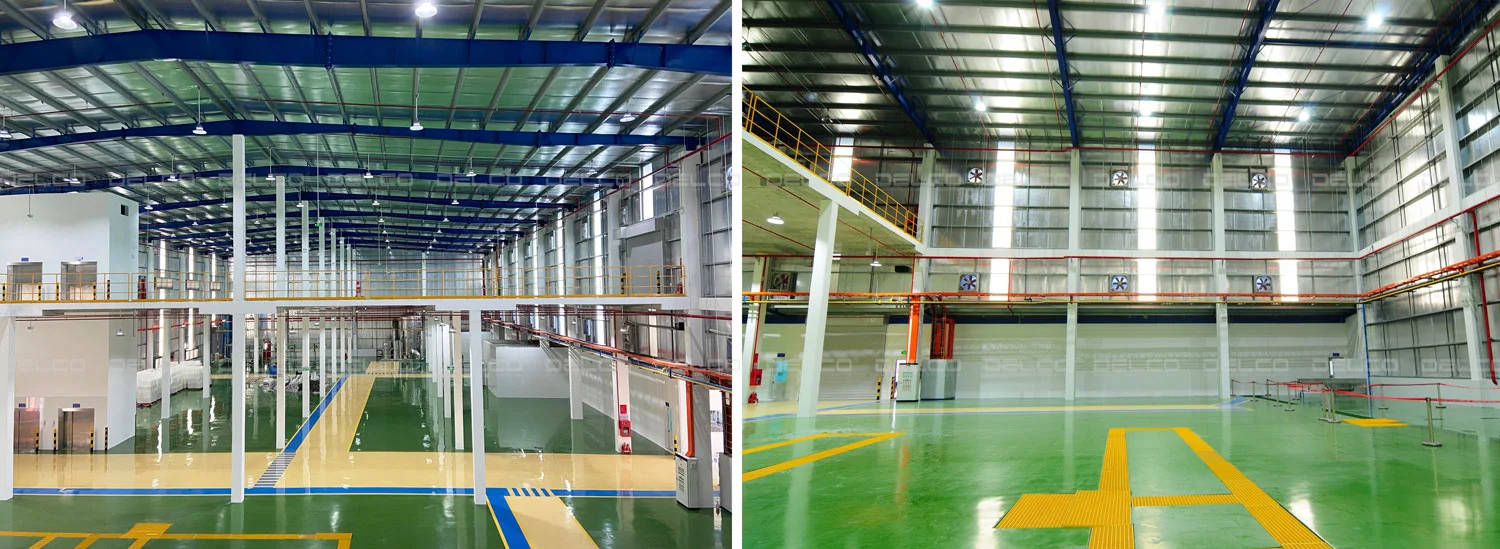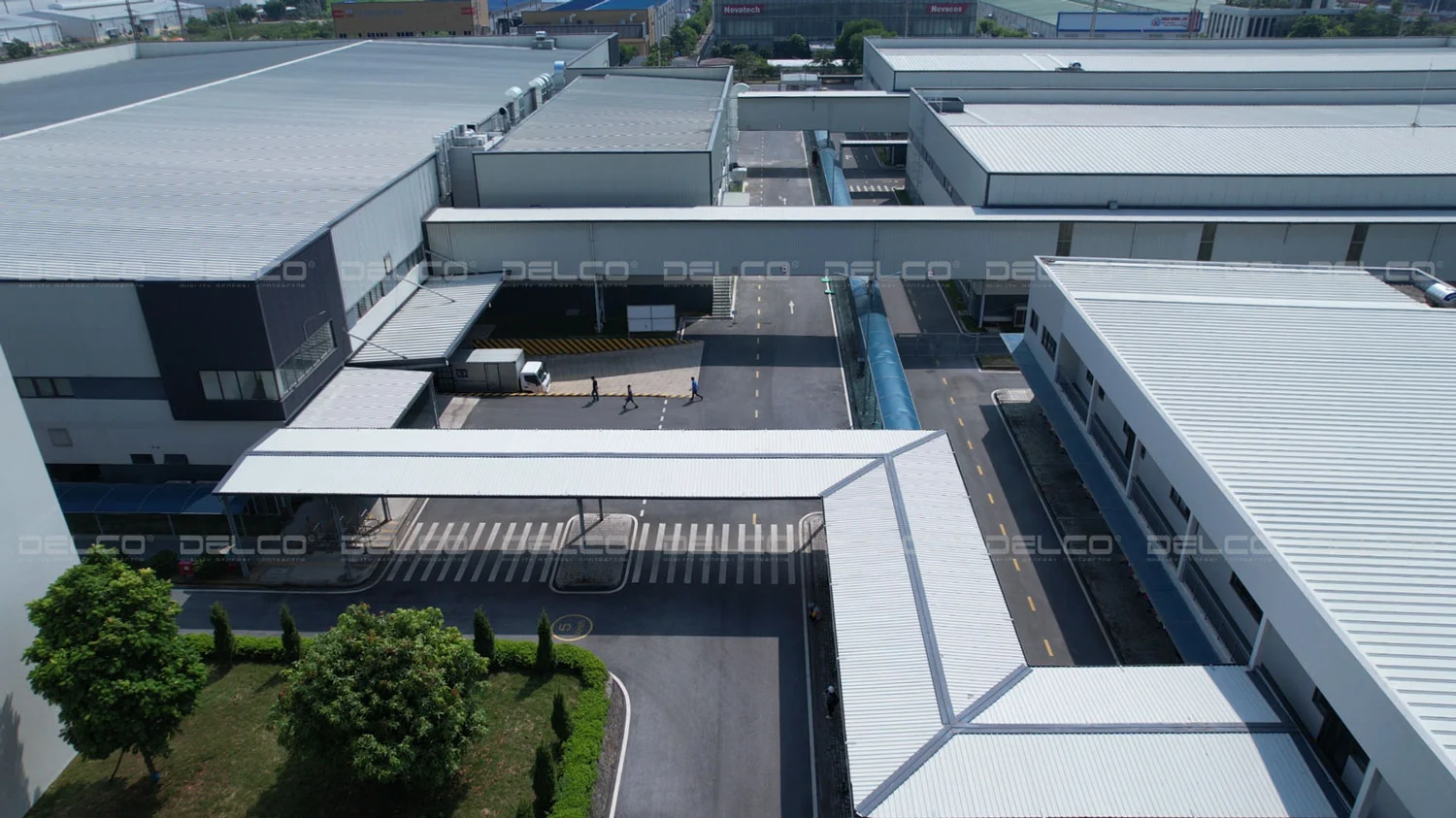In Vietnam, the current lighting standard is TCVN 7114:2008, regulating technical indicators such as glare, illuminance, and color rendering index(CRI) to create a safe and suitable lighting environment for work, enhancing physical and mental health for workers.
Vietnamese lighting standard for workshop
Lighting standards regulate on technical indicators of lighting such as glare, illuminance and color rendering index (CRI) to guarantee a safe and suitable lighting environment for work, enhancing physical and mental health for workers. Currently, popular lighting standards do not specify the type of lighting but only the technical parameters of lighting, therefore, investors have a variety of options for the lighting system of the workshop.

Lighting system at DORCO Living Vina factory, the project DELCO worked as the General Construction Contractor.
The Vietnamese lighting standard TCVN 7114-1:2008 has main contents equivalent to the European lighting standard EN 12464-1, both specifying technical parameters such as glare distribution, illuminance and color rendering index (CRI). However, there are a few differences. For example, according to European standards, the illuminance scale ranges from 7.5 – 10,000 lux and there are detailed regulations on indirect lighting on ceilings, wall-mounted lighting with cylindrical luminosity. Meanwhile, in Vietnam, the recommended illuminance scale ranges from 20 to 5,000 lux, with additional regulations on lighting direction, daylighting, tailored to the environmental conditions and climate of Vietnam.
Vietnamese lighting standards for workshops and factories (TCVN 7114-1:2008)
General recommendations
To reduce glare in the workshop, avoid lights in areas that might cause discomfort to vision, contractors should use materials with low gloss on working surfaces, increase the illuminated area of the lighting… The illuminance should be within the recommended range as specified by the lighting standard TCVN 7114-1:2008: 20 – 30 – 50 – 75 – 100 – 150 – 200 – 300 – 500 – 750 – 1000 – 2000 – 3000 – 5000 lux.
In addition, to avoid flickering affecting the eyes as well as the productivity of workers, contractors should apply measures such as: using direct current power sources, installing lamps with high frequencies (30kHz). Furthermore, lighting with a CRI) lower than 80Ra should not be used for areas where work is performed regularly or where accurate color perception is necessary.

The lighting system of TOYO Solar factory office, the project DELCO worked as the Design-Build contractor for finishing and office interior items.
Detailed technical regulation on lighting standard for workshops and factories
Glare
To reduce glare, contractors should use suitable materials to shield light bulbs. Shielding angles are specified differently depending on the glare of the bulbs, but should not be less than the values specified as follows:
| Glare of light bulbs (kcd/m²) | Minimum hidden angle |
| From 1 to 20 | 10⁰ |
| From 20 to 50 | 15⁰ |
| From 50 to 500 | 20⁰ |
| ≥ 500 | 30⁰ |

Lighting system at PREC factory, the project DELCO worked as the Design-Build contractor.
Illuminance
Vietnamese lighting standards regulate on the maintained illuminance in each working area of the workshop, as well as stipulate a uniformity of minimum illuminance, which is 0.7 in the working area and a minimum of 0.5 in the surrounding areas.
| Illuminance at the workplace (lux) | Illuminance in the surrounding area (lux) |
| ≥ 750 | 500 |
| 500 | 300 |
| 500 | 200 |
| ≤ 200 | Equal to the illuminance at the workplace |

The lighting system at the GS Battery workshop in Binh Duong, the project DELCO worked as the Design-Build contractor.
Color rendering coefficient (CRI color rendering index)
The Color Rendering Index (CRI) ranges from 1 to 100 (Ra), the higher the level, the more realistic the light color. Moreover, the CRI index also affects the quality of products with high color accuracy requirements such as printing, graphic design, fashion…

Detailed technical regulation on maintained illuminance, glare coefficient and color rendering coefficients of popular workshops in Vietnam
Maintained illuminance, Unified Glare Rating (UGR) limit, and Color Rendering Index (CRI) are the three important factors that contractors need to pay attention to when designing lighting systems. In which the maintained illuminance is a unit expressing the brightness in an area, UGR is a criterion for evaluating discomfort glare, and CRI is an index of the color fidelity of light when projected onto an object.
The table specifies the lighting standards for offices and common workshops according to TCVN 7114-1:2008.
| Room type, job or activity | Maintained illuminance (Ēmlux) | Glare rating limit (URG) | Color rendering coefficient (Ra) |
| Office | |||
| Document storage room photocopy area, circulation areas… | 300 | 19 | 80 |
| Open space working area, typing, reading, writing, data processing area | 500 | 19 | 80 |
| Graphic design room | 750 | 16 | 80 |
| Computer room | 500 | 19 | 80 |
| Meeting room | 500 | 19 | 80 |
| Reception desk | 300 | 22 | 80 |
| Storage room | 200 | 25 | 80 |
| Printing industry | |||
| Printing press room, paper cutting, gilding, embossing, engraving, mold making area | 500 | 19 | 80 |
| Paper sorting and manual printing area | 500 | 19 | 80 |
| Typesetting, correcting impressions, lithographic printing area | 1000 | 19 | 80 |
| Color checking area | 1500 | 16 | 90 |
| Steel and copper engraving | 2000 | 16 | 80 |
| Food Industry | |||
| Work area in the brewery, malt workshop, washing, barreling, sieve cleaning, peeling area, cooking area in the jam and chocolate factory, work area in the sugar factory, drying and fermenting raw tobacco, fermentation cellar | 200 | 25 | 80 |
| Sorting, washing products, grinding, mixing and packaging area | 300 | 25 | 80 |
| Work area in the slaughterhouse, butcher shop, dairy plant, on the filtration floor, sugar refining area | 500 | 25 | 80 |
| Vegetable cutting and sorting area | 300 | 25 | 80 |
| Ready meal processing area, kitchen | 500 | 22 | 80 |
| Cigar and tobacco production area | 500 | 22 | 80 |
| Glass and bottle inspection area, product testing, retouching, sorting, labeling area | 500 | 22 | 80 |
| Laboratory | 500 | 19 | 80 |
| Color checking area | 1000 | 16 | 90 |
| Automobile Manufacturing | |||
| Car body making and assembly area | 500 | 22 | 80 |
| Painting room, spray booth, polishing booth | 750 | 22 | 80 |
| Painting room: repair, inspection | 1000 | 16 | 90 |
| Stuffed chair manufacturing area | 1000 | 19 | 80 |
| Finishing inspection area | 1000 | 19 | 80 |
| Leather Industry | |||
| Tanks, soaking vats, leather storage pits | 200 | 25 | 40 |
| Filtering, skiving, buffing and shaking leather area | 300 | 25 | 80 |
| Saddle making, shoemaking, stitching, sewing, polishing, shaping, cutting, stamping area | 500 | 22 | 80 |
| Sorting area | 500 | 22 | 90 |
| Leather dyeing area (dyeing machine) | 500 | 22 | 80 |
| Check quality area | 1000 | 19 | 80 |
| Color checking area | 1000 | 16 | 90 |
| Shoemaking area | 500 | 22 | 80 |
| Glove making area | 500 | 22 | 80 |
See more: Notes when designing and constructing the factory’s mechanical and electrical systems
See more: Criteria for office and factory canteen design






